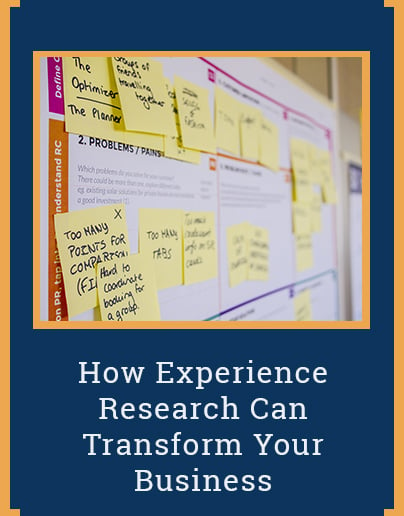The most valuable brands use research to gain a deep understanding of their audience. With this knowledge in hand, companies are able to make informed decisions, create inspired solutions, and reduce risk. They can more easily prioritize their efforts and validate offerings and features. And with a user-centric design focus, they’re able to optimize workflows and improve user satisfaction.
Taking Research to the Next Level
At Intevity, we take a multidisciplinary approach to research. We call it “Experience Research”. It brings together user, customer, and business research. It’s a set of tools and processes for learning about users’ behaviors, needs, motivations, pain points, and goals.

Experience Research enables a deep understanding of users. Its goal is to improve adoption rates and user engagement, and reduce error rates. For internal projects––like a software upgrade–– effective research can lead to increased job satisfaction and retention rates.
Research is used at every stage of a project lifecycle––beginning with upfront exploratory research, all the way through to end user validation, and iteration and improvement planning. It focuses on the five W’s: “Who”, “What”, “Why”, “When”, and “Would”.
Conducting research throughout the product lifecycle identifies additional opportunities, unmet needs, and emerging trends. It creates alignment on expectations. It can also lead to increased stakeholder buy-in by giving decision makers a deeper understanding of users. Meanwhile, users feel buoyed by having someone listen to their needs.
"If you wait until there is another case study in your industry, you will be too late." – Seth Godin
Why is research worth the investment
Naysayers of research often focus on the expense and time required. They also often question the need for research. They might say: “Why do we need to talk to the users? We know more about this topic than they do. Just go build it.” In the product management realm, this is known as “inside-outside thinking”.

This inside-outside approach is typified by focusing on improving internal operational efficiencies. It often aims to repackage or recombine existing tools in the hope of yielding a breakthrough product.
A classic example of inside-outside thinking is Blockbuster Video. Their failure to understand the underlying emotions of their customers––i.e. empathy––ultimately led to their failure. Meanwhile, Netflix was able to tap into those emotions by creating a product that more strongly resonated with customers.
Time spent upfront on research reduces work later. Aligning user goals with organizational goals makes it possible to quantify the return of an improved design. It can also encourage focus on enhancements that will add value to both the user and the agency.
How Intevity Can Guide Your Research Efforts
Whatever the focus of your challenge––program, product, data, platform, innovation––we recognize that organizations need to move with guile and speed, while avoiding over-commitment.
Our team can lead research to serve as an organizational change catalyst. We’ll validate that problems are the right ones to solve, and put together an action plan to move from strategy to reality.
Want to transform your business with Experience Research? We’d love to hear from you.

